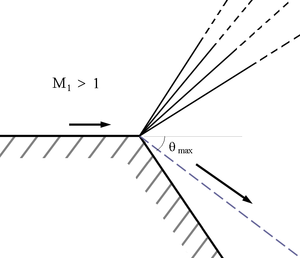
Prandtl-Meyer expansion fan
Encyclopedia

Convex set
In Euclidean space, an object is convex if for every pair of points within the object, every point on the straight line segment that joins them is also within the object...
corner. The fan consists of an infinite number of Mach wave
Mach wave
In fluid dynamics, a Mach wave is a pressure wave traveling with the speed of sound caused by a slight change of pressure added to a compressible flow. These weak waves can combine in supersonic flow to become a shock wave if sufficient Mach waves are present at any location. Such a shock wave is...
s, diverging from a sharp corner. In case of a smooth corner, these waves can be extended backwards to meet at a point. Each wave in the expansion fan turns the flow gradually (in small steps). It is physically impossible to turn the flow away from itself through a single "shock" wave because it will violate the second law of thermodynamics
Second law of thermodynamics
The second law of thermodynamics is an expression of the tendency that over time, differences in temperature, pressure, and chemical potential equilibrate in an isolated physical system. From the state of thermodynamic equilibrium, the law deduced the principle of the increase of entropy and...
. Across the expansion fan, the flow accelerates (velocity increases) and the Mach number
Mach number
Mach number is the speed of an object moving through air, or any other fluid substance, divided by the speed of sound as it is in that substance for its particular physical conditions, including those of temperature and pressure...
increases, while the static pressure
Static pressure
In fluid mechanics the term static pressure has several uses:* In the design and operation of aircraft, static pressure is the air pressure in the aircraft’s static pressure system....
, temperature
Temperature
Temperature is a physical property of matter that quantitatively expresses the common notions of hot and cold. Objects of low temperature are cold, while various degrees of higher temperatures are referred to as warm or hot...
and density
Density
The mass density or density of a material is defined as its mass per unit volume. The symbol most often used for density is ρ . In some cases , density is also defined as its weight per unit volume; although, this quantity is more properly called specific weight...
decrease. Since the process is isentropic, the stagnation properties remain constant across the fan.
Flow properties
The expansion fan consists of infinite number of expansion waves or Mach lines. The first Mach line is at an angle with respect to the flow direction and the last Mach line is at an angle
with respect to the flow direction and the last Mach line is at an angle  with respect to final flow direction. Since the flow turns in small angles and the changes across each expansion wave are small, the whole process is isentropic. This simplifies the calculations of the flow properties significantly. Since the flow is isentropic, the stagnation properties like stagnation pressure (
with respect to final flow direction. Since the flow turns in small angles and the changes across each expansion wave are small, the whole process is isentropic. This simplifies the calculations of the flow properties significantly. Since the flow is isentropic, the stagnation properties like stagnation pressure ( ), stagnation temperature
), stagnation temperatureStagnation temperature
In thermodynamics and fluid mechanics, stagnation temperature is the temperature at a stagnation point in a fluid flow. At a stagnation point the speed of the fluid is zero and all of the kinetic energy has been converted to internal energy and is added to the local static enthalpy...
(
 ) and stagnation density (
) and stagnation density ( ) remain constant. The final static properties are a function of the final flow Mach number (
) remain constant. The final static properties are a function of the final flow Mach number ( ) and can be related to the initial flow conditions as follows,
) and can be related to the initial flow conditions as follows,
The Mach number after the turn (
 ) is related to the initial Mach number (
) is related to the initial Mach number ( ) and the turn angle (
) and the turn angle ( ) by,
) by,
where,
 is the Prandtl–Meyer function. This function determines the angle through which a sonic flow (M
is the Prandtl–Meyer function. This function determines the angle through which a sonic flow (MMach number
Mach number is the speed of an object moving through air, or any other fluid substance, divided by the speed of sound as it is in that substance for its particular physical conditions, including those of temperature and pressure...
= 1) must turn to reach a particular Mach number (M). Mathematically,
-

By convention,
Thus, given the initial Mach number ( ), one can calculate
), one can calculate  and using the turn angle find
and using the turn angle find  . From the value of
. From the value of  one can obtain the final Mach number (
one can obtain the final Mach number ( ) and the other flow properties.
) and the other flow properties.
Maximum turn angle
As Mach number varies from 1 to
 ,
,  takes values from 0 to
takes values from 0 to  , where
, where
This places a limit on how much a supersonic flow can turn through, with the maximum turn angle given by,
One can also look at it as follows. A flow has to turn so that it can satisfy the boundary conditions. In an ideal flow, there are two kinds of boundary condition that the flow has to satisfy,- Velocity boundary condition, which dictates that the component of the flow velocity normal to the wall be zero. It is also known as no-penetration boundary condition.
- Pressure boundary condition, which states that there cannot be a discontinuity in the static pressure inside the flow (since there are no shocks in the flow).
If the flow turns enough so that it becomes parallel to the wall, we do not need to worry about this boundary condition. However, as the flow turns, its static pressure decreases (as described earlier). If there is not enough pressure to start with, the flow won't be able to complete the turn and will not be parallel to the wall. This shows up as the maximum angle through which a flow can turn. The lower the Mach number is to start with (i.e. small ), the greater the maximum angle through which the flow can turn.
), the greater the maximum angle through which the flow can turn.
The streamlineStreamlines, streaklines and pathlinesFluid flow is characterized by a velocity vector field in three-dimensional space, within the framework of continuum mechanics. Streamlines, streaklines and pathlines are field lines resulting from this vector field description of the flow...
which separates the final flow direction and the wall is known as a slipstream (shown as the dashed line in the figure). Across this line there is a jump in the temperature, density and tangential component of the velocity (normal component being zero). Beyond the slipstream the flow is stagnant (which automatically satisfies the velocity boundary condition at the wall). In case of real flow, a shear layer is observed instead of a slipstream, because of the additional no-slip boundary conditionNo-slip conditionIn fluid dynamics, the no-slip condition for viscous fluids states that at a solid boundary, the fluid will have zero velocity relative to the boundary.The fluid velocity at all fluid–solid boundaries is equal to that of the solid boundary...
.
See also
- Gas dynamicsGas dynamicsGas dynamics is a branch of fluid dynamics concerned with studying the motion of gases and its consequent effects. Gas dynamics combines the principles of fluid mechanics and thermodynamics...
- Mach waveMach waveIn fluid dynamics, a Mach wave is a pressure wave traveling with the speed of sound caused by a slight change of pressure added to a compressible flow. These weak waves can combine in supersonic flow to become a shock wave if sufficient Mach waves are present at any location. Such a shock wave is...
- Oblique shockOblique shockAn oblique shock wave, unlike a normal shock, is inclined with respect to the incident upstream flow direction. It will occur when a supersonic flow encounters a corner that effectively turns the flow into itself and compresses. The upstream streamlines are uniformly deflected after the shock wave...
- Shock waveShock waveA shock wave is a type of propagating disturbance. Like an ordinary wave, it carries energy and can propagate through a medium or in some cases in the absence of a material medium, through a field such as the electromagnetic field...
- Shadowgraph techniqueShadowgraphShadowgraph is an optical method that reveals non-uniformities in transparent media like air, water, or glass. It is related to, but simpler than, the schlieren and schlieren photography methods that perform a similar function...
- Schlieren photographySchlieren photographySchlieren photography is a visual process that is used to photograph the flow of fluids of varying density. Invented by the German physicist August Toepler in 1864 to study supersonic motion, it is widely used in aeronautical engineering to photograph the flow of air around objects...
External links
- Expansion fan (NASANASAThe National Aeronautics and Space Administration is the agency of the United States government that is responsible for the nation's civilian space program and for aeronautics and aerospace research...
) - Prandtl- Meyer expansion fan calculator (Java appletJava appletA Java applet is an applet delivered to users in the form of Java bytecode. Java applets can run in a Web browser using a Java Virtual Machine , or in Sun's AppletViewer, a stand-alone tool for testing applets...
).
-



